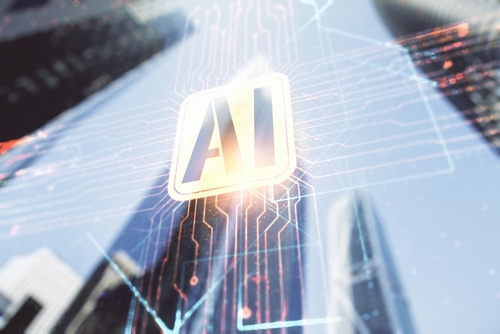Industry-wide demand is mounting to rethink how we create energy-efficient, comfortable, and smart buildings. More facilities managers are turning to technology to help create smart building systems that use real-time data to adjust temperature and lighting, monitor air quality, and other maintenance controls.

The market for Internet of Things (IoT) platforms is expected to hit $101 billion in just five years. These platforms connect IoT devices like sensors and cameras to collate building data and suggest actions accordingly, like switching off the air conditioning in an empty large room.
There’s also the exciting prospect of artificial intelligence (AI) in the physical world. This latest innovation for building modernization promises to bridge the gap between AI and its physical surroundings, allowing digital tools to control their environments. So, rather than flagging that air conditioning isn’t needed in an unoccupied room, the smart system switches it off.
AI’s capabilities in the built environment create a lot of excitement, with leaders attracted to AI-driven operations to help mitigate human error and cut down the legwork behind repetitive processes. According to Gartner, 94% of power and utility CIOs plan on investing in AI for operations this year.
Yet amid all this promise and excitement around AI, facilities managers are hesitating. Uncertainty and lack of access are the biggest barriers they’re dealing with, and they’re worried that adding new technology could lead to more complexities.
Fortunately, there is a remedy for this: building the right blueprint for integrating AI alongside existing digital infrastructures, including outdated ones.
Where AI Hesitation Stems From
Most facilities managers will be able to speak to their experience with dealing with operational and technical challenges when deploying new technology into their buildings. Disconnected systems, which have been a pervasive problem in older buildings, are primarily to blame for this. They lead to other issues like missing data and inefficiencies that pile up costs rather than cut them.
There’s also the matter of the “automation trap,” where facilities managers are misled about AI solutions that are just automation repackaged. This is an important distinction to make: AI is not automation. This misconception is rooted in the widespread understanding that AI functions as a “black box,” where the inner workings are a total mystery, and it simply automates processes. This isn’t the case; AI is dynamic, learning, and adapting to insights it’s fed in real time.
A “black box” approach is not the way to go, especially when adding new tools alongside older solutions. It’s understandable that hesitation towards adopting AI still exists in the building industry, given that “black box” attempts to automate HVAC systems in the past often caused breakdowns, costing thousands of dollars each time.
Now, though, AI innovation has evolved so that it can be managed from a unified platform. Rather than inserting an AI solution into an existing infrastructure as an afterthought, as is often the case with a retrofit approach, integration and unification are key. That way, facilities managers can more effectively modernize their buildings from the inside out, even when dealing with aged infrastructure.
Smart Buildings Require Integrated and Unified Infrastructures
A unified platform at the foundation of a building’s digital infrastructure is at the heart of a scalable, intuitive, and maximally efficient AI stack. With a unified platform, AI can feed and process data and provide accurate and up-to-date insights, ensuring operations continue smoothly and flagging anomalies or issues when they arise.
Think about it this way: It’s not AI that just automates whether lights are turned down on a scheduled input; it learns and informs when it makes the most sense to switch them off, depending on real-time occupancy and desired energy—and cost-saving goals.
To ensure the system is fully unified, check that the prompts and insights are visible and accessible across a digital infrastructure via a unified platform. This will ensure that the whole picture is seen and acted on rather than disjointed pieces that lead to operational issues in HVAC systems and beyond.
Steps to Achieve Integrated Modernization
Data is the first point of call for effectively modernizing buildings with AI. Siloed data exacerbates system fragmentation. Ensuring strong data management is at the heart of tackling interoperability hurdles. Assess data inputs, determine whether data formats are transferable between connected solutions, and ensure data is stored and organized properly to avoid missing key information.
Next, the current operational needs must be carefully evaluated to determine where to introduce technology and what solutions are needed. Technology should address specific gaps, such as cutting down on excess heating if energy costs from this are a concern and occupancy frequently changes. Adding in digital solutions simply for the sake of having new technology is a slippery slope to worsening interoperability issues, which often leads facilities managers to invest in other technologies to try to resolve this. It’s the paradox of poorly planned retrofitting, but it’s a situation that can be avoided with careful planning. Additionally, pinpoint whether adding software will also require hardware upgrades. These can rack up costs quickly while further complicating modernization processes.
Facilities managers must also measure progress to gauge ROI and improve building performance. Modernization isn’t static; there will always be areas for further improvement in operations, which is one of the reasons AI adoption is growing. Keeping a pulse on what’s going well and what needs changing helps identify whether investing in a device or solution is required and where adjustments are needed.
Finally, don’t forget the human role in the equation. People need to be trained in overseeing and interacting with AI and using it to empower their decision-making. In addition to hands-on training initiatives with these tools, implement a management framework with distinct protocols for accountability, intervention, security, and overriding these tools.
Modernizing buildings, even older ones, doesn’t have to mean starting from scratch. With an integrated and unified approach, facilities managers can leverage AI alongside existing infrastructures to achieve their operational goals.

Gaku Ueda is CEO of MODE Inc., an AI solution provider for buildings.
ALSO WATCH: FMA Shorts: Will AI Be a Job Killer for Facilities Managers?
